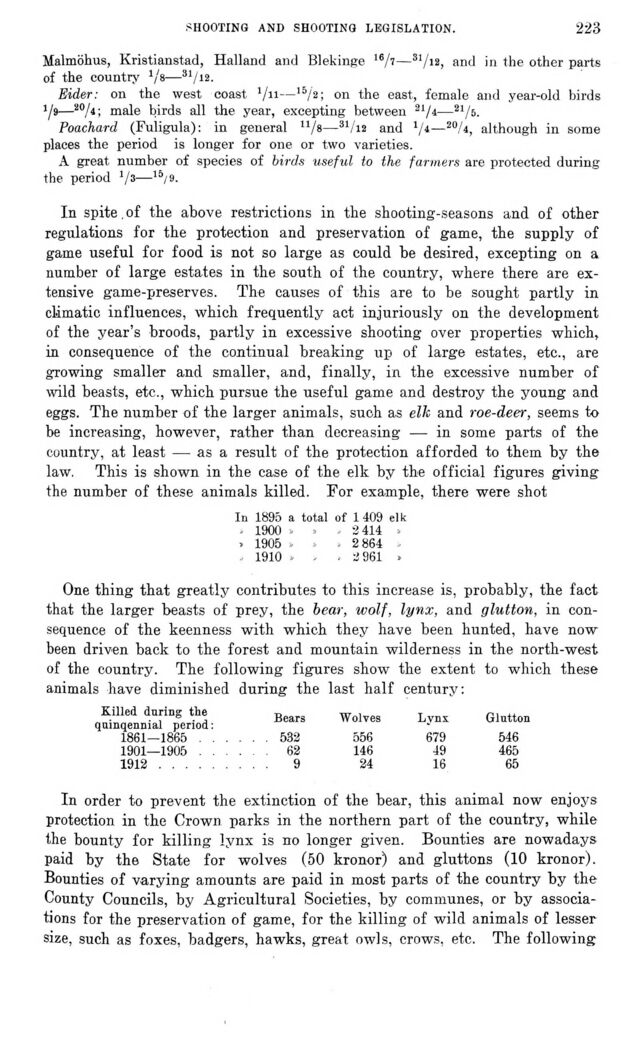
Full resolution (JPEG) - On this page / på denna sida - V. Shooting and Fishing - 1. Shooting and Shooting Legislation. By A. Wahlgren

<< prev. page << föreg. sida << >> nästa sida >> next page >>
Below is the raw OCR text
from the above scanned image.
Do you see an error? Proofread the page now!
Här nedan syns maskintolkade texten från faksimilbilden ovan.
Ser du något fel? Korrekturläs sidan nu!
This page has never been proofread. / Denna sida har aldrig korrekturlästs.
shooting and shooting legislation.
223
Malmöhus, Kristianstad, Halland and Blekinge 16/’—3I/12> and in the other parts
of the country 1/s—31/12.
Eider: on the west coast 1/n—15/2; on the east, female and year-old birds
Y9—20fi-, male birds all the year, excepting between 31 /i—21/s.
Poachard (Fuligula): in general u/s—31/i2 and 1/i—20/4, although in some
places the period is longer for one or two varieties.
A great number of species of birds useful to the farmers are protected during
the period V3—15/9-
In spite, of the above restrictions in the shooting-seasons and of other
regulations for the protection and preservation of game, the supply of
game useful for food is not so large as could be desired, excepting on a
number of large estates in the south of the country, where there are
extensive game-preserves. The causes of this are to be sought partly in
climatic influences, which frequently act injuriously on the development
of the year’s broods, partly in excessive shooting over properties which,
in consequence of the continual breaking up of large estates, etc., are
growing smaller and smaller, and, finally, in the excessive number of
wild beasts, etc., which pursue the useful game and destroy the young and
eggs. The number of the larger animals, such as elk and roe-deer, seems to
be increasing, however, rather than decreasing — in some parts of the
country, at least — as a result of the protection afforded to them by the
law. This is shown in the case of the elk by the official figures giving
the number of these animals killed. For example, there were shot
In 1895 a total of 1409 elk
1900 » » - 2 414 »
> 1905 a * - 2 864
1910 * , • 2 961 »
One thing that greatly contributes to this increase is, probably, the fact
that the larger beasts of prey, the bear, wolf, lynx, and glutton, in
consequence of the keenness with which they have been hunted, have now
been driven back to the forest and mountain wilderness in the north-west
of the country. The following figures show the extent to which these
animals have diminished during the last half century:
Killed during the Bearg Wolyes L Q1 t
qumqenmal period:
1861—1865 ...... 532 556 679 546
1901—1905 ...... 62 146 49 465
1912 ......... 9 24 16 65
In order to prevent the extinction of the bear, this animal now enjoys
protection in the Crown parks in the northern part of the country, while
the bounty for killing lynx is no longer given. Bounties are nowadays
paid by the State for wolves (50 kronor) and gluttons (10 kronor).
Bounties of varying amounts are paid in most parts of the country by the
County Councils, by Agricultural Societies, by communes, or by
associations for the preservation of game, for the killing of wild animals of lesser
size, such as foxes, badgers, hawks, great owls, crows, etc. The following
<< prev. page << föreg. sida << >> nästa sida >> next page >>